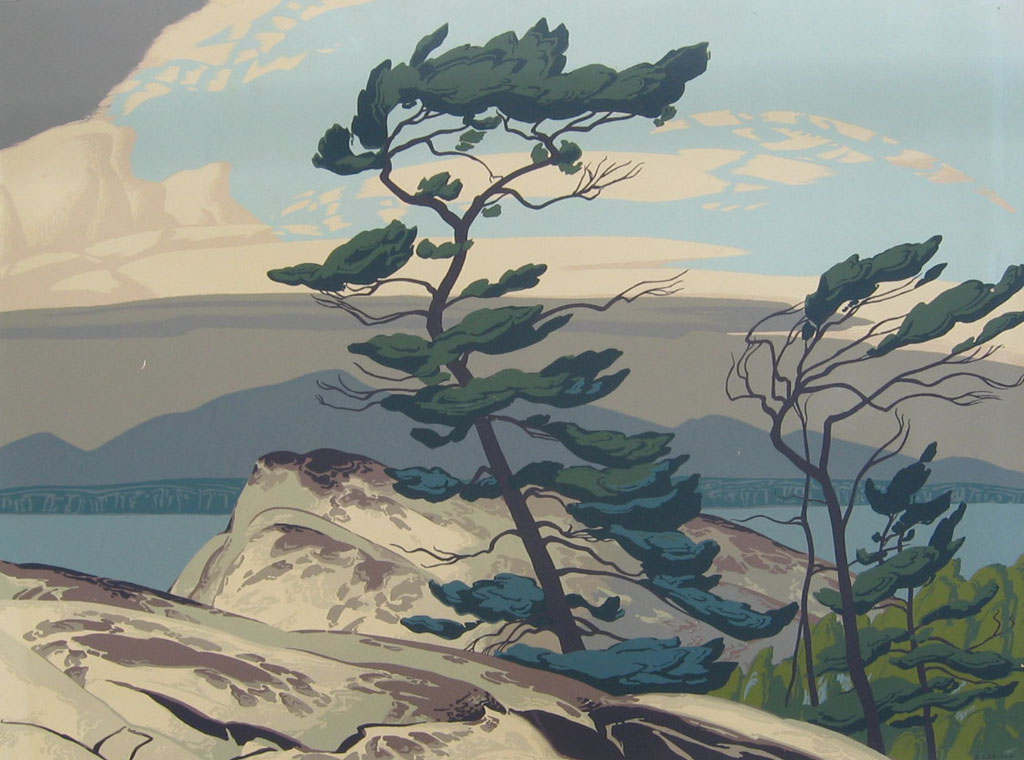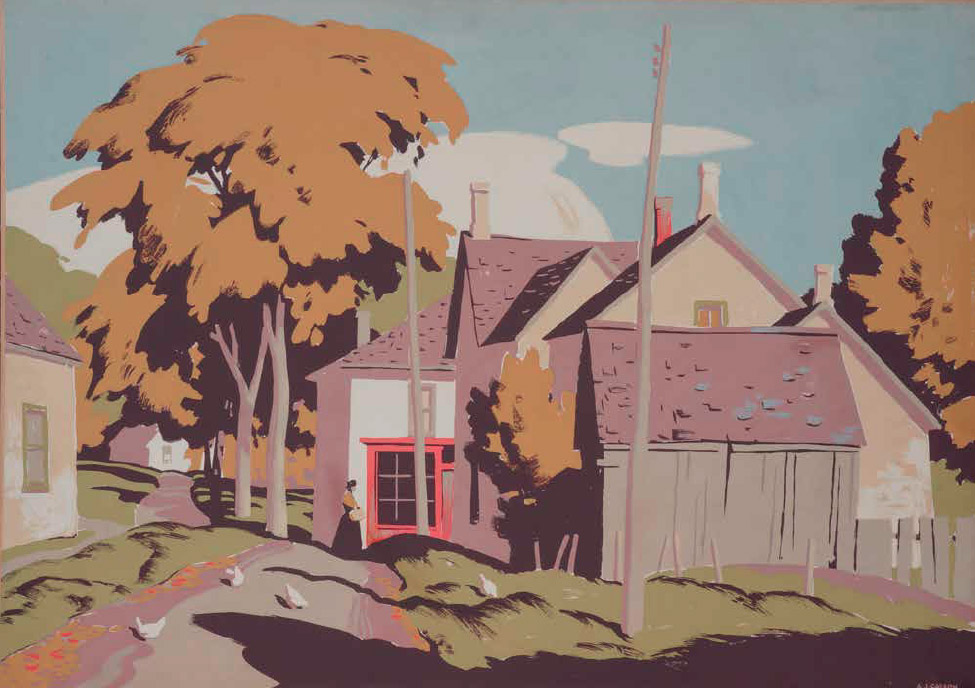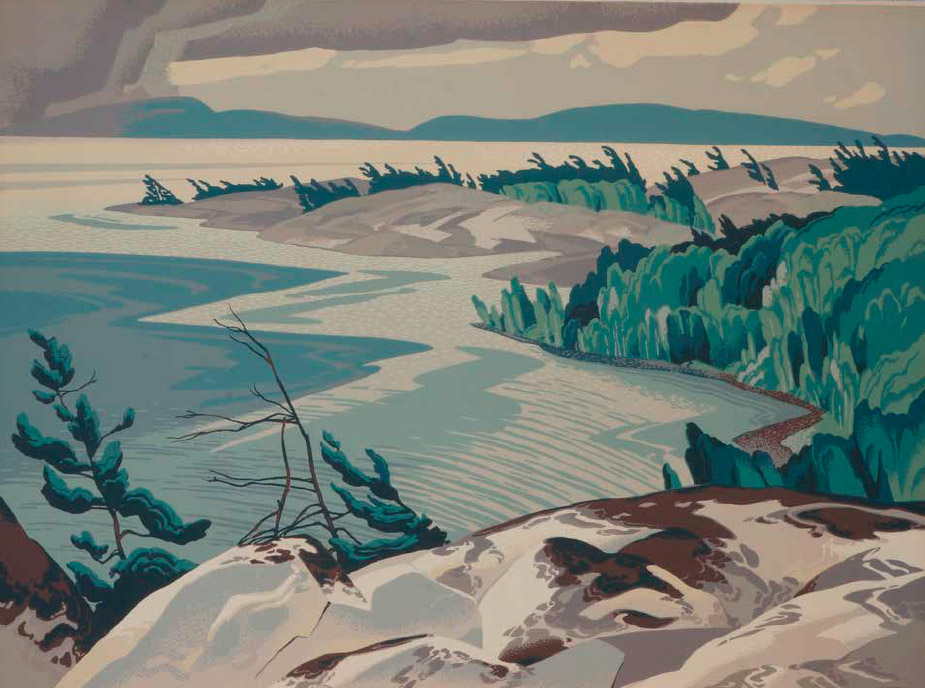Canadian artist Alfred Joseph Casson was born in Toronto, Ontario of an English father and a Canadian mother. His family moved to Hamilton in 1912, and there he studied under John S. Gordon at the Hamilton Technical School. At the age of 16 he was apprenticed to the Laidlaw Lithography Company in Hamilton, where he retouched photographs, laid patterns and engraved on zinc plates.
Casson was then hired by the Commercial Engravers Company in Hamilton. When his family moved back to Toronto in 1915, he worked as a freelance designer. In the evenings he attended the Central Technical School, where he studied under Alfred Howell from 1915 to 1917. He then studied at the Ontario College of Art under J.W. Beatty and took private classes under Harry Britton who first taught him water colour techniques and introduced him to oil painting.
In 1919, Casson was employed by the firm of Rous & Mann Limited as assistant designer to Franklin Carmichael, serving a seven-year apprenticeship which led him back to the field of freelance designing. During this period he benefited greatly from Carmichael’s high standards in daily work and became a good friend and sketching companion. Through Carmichael, Casson met members of the Group of Seven at the Arts and Letters Club.
In 1921 Casson made his first extended painting trip with Carmichael to Lake Rosseau in the Muskoka district, and exhibited for the first time with the Ontario Society of Artists. In 1923, his work ‘Clearing’ was purchased by the National Gallery of Canada. While working in oils, Casson was also developing his watercolour skills, and in 1925 with Carmichael and F.H. Brigden he formed the Canadian Society of Painters in Water Colour “to encourage and foster the art of water-colour in Canada”. In 1926, Casson was invited to join the Group of Seven when F.H. Johnston – who wanted to paint more marketable, realistic scenes – departed the group.
In the same year, Casson started work for the firm of Sampson-Matthews and continued to sketch with Carmichael on the weekends. In the Yearbook of Arts in Canada, F.B. Housser wrote, “Carmichael and Casson are painting in water colours… giving to Canadian landscape a statement in water colour as bold and untraditional as that which some of their associates have given in oils.”
Many of Casson’s large canvases were done between 1926 and 1930, when he sketched in the Haliburton and Lake Superior regions. The early emergence of his individuality was noted by Paul Duval, as was later his change in style in 1944, when pattern became the vital element in his work.
It was around 1924 that Casson began to focus on the Ontario village. He made many sketches of structural details which became a valuable reference for his larger studies in oils, like his magnificent ‘Anglican Church At Magnetawan’, painted in 1933. A fall while skating in 1924 agitated a kidney stone, and he was advised by his doctor to avoid outdoor sketching for a year. Instead, he spent weekends painting flowers in the greenhouses of the Allen Gardens in Toronto, and produced a series of small glowing panels of flowers and still lifes.
Casson’s strong sense of design may have been due to his growing interest in various types of reproduction. As Vice President and Art Director for Sampson-Matthews for almost 20 years, he was responsible for the technical development of programmes in connection with reproduction of artists’ works carried out by the National Gallery of Canada, Canadian Pulp and Paper Association and Sampson-Matthews Limited. His article entitled ‘The Possibilities of Silk Screen Reproduction’ appeared in Canadian Art in 1949, in which one of his own prints, ‘Mill Village’ was reproduced. His heraldic work was also reproduced by Sampson-Matthews, including armorial bearings of Canada and her ten provinces, and a series of landscapes including ‘White Pine’, ‘Fisherman’s Point’, ‘Summer Morning’, ‘McGregor Bay’ and ‘Poplar’. His paintings of northern Ontario landscapes and villages won him several awards.
Casson was a prolific artist. He did many small sketches in oils on panels in various sizes, many of which he later destroyed as he considered them beneath the standards he achieved in later years. Only a few were saved for friends. Some public collections include these small sketches, including that of the late Professor O.J. Firestone of Ottawa, who faithfully acquired 138 works covering Casson’s entire painting career from 1918 to 1976. This collection was donated by the O.J. Firestone Collection to the Ontario Heritage Foundation in 1972.
Bob and Signe McMichael assembled their magnificent McMichael Conservation Collection of Art in Kleinburg, Ontario – which includes 45 or more Casson works. Their collection was also donated to the Ontario Heritage Foundation in 1965.
Casson lived in North Toronto with his wife until his death at the age of 93. He was not only one of Canada’s most able artists, but also one of the most highly regarded. He is represented in many public Canadian collections including the National Gallery of Canada, the Art Gallery of Ontario, the McMichael Canadian Art Collection, Hart House, the Art Gallery of Hamilton, LRA&HM in London, Gallery Lambton in Sarnia, the Montreal Museum of Fine Art and many private collections.
He was involved in several art organisations including the Ontario Society of Artists, the Canadian Society of Painters in Water Colour, the Group of Seven, the Royal Canadian Academy and the Canadian Group of Painters.



